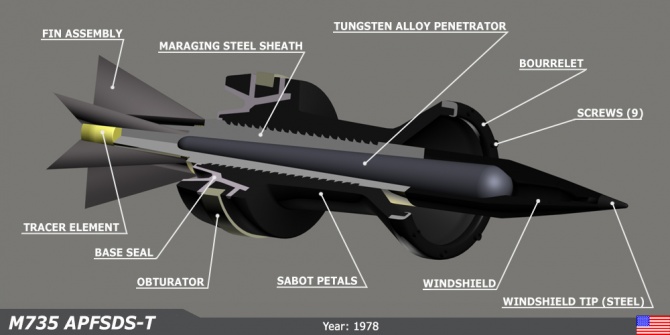M735
Statistics
Maximum Range: 3000m
Armor Penetration: 410mm RHAe (KE)
Muzzle Velocity: 1501m/s
Date Fielded: 1978
General
The M735 is a U.S. APFSDS round developed by the Ballistic Research Laboratory (BRL) at Aberdeen Proving Ground and the Armaments Research, Development and Engineering Center at Picatinny Arsenal in the late 1970s for the M68 series of 105mm rifled tank guns to replace the M728 APDS. It consists of a tungsten core sheathed in a maraging steel body with a aluminum windscreen and steel windscreen tip, mounted inside a three segment aluminum sabot. A steel bourrelet is secured to the face of the sabot petals with screws and the aluminum fin assembly is fitted with an M13 tracer element.
Fielded in 1978, the M735 served as the U.S. military's primary wartime anti-armor round until superseded by the M774 APFSDS-T in 1980. The M735 is capable of penetrating the frontal aspects of the T-62, T-64A, and T-72 Ural beyond 2000m but will struggle against the T-64B and T-80A/B beyond 1500m. The turrets of later generation Soviet tanks, such as the T-72A and T-72B are effectively invulnerable to M735 across the frontal arc, but flank performance remains acceptable.
Despite being supplanted by the M774, the M735 continued in front line service well into the mid-1980s, particularly with M60 equipped units, and was the standard "go to war" round for the USMC until the 1991 Gulf War.
